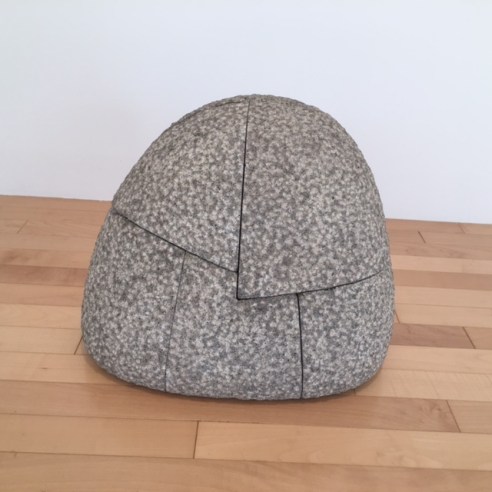175 – Young Mountain

Seeing a single work in its intended context, or any context that feels like its home, makes all the difference. It had been years since I had been to The Noguchi Museum in Queens. I was enamored with the textures and surfaces. There were cool slate slabs and warm wood ceilings and rough concrete. So many of the works were perfect in these surroundings and the space felt complete.
There was one piece, a stone, about the size of a handmade loaf of Bronx bread, that I found remarkable. The name and date of the stone I either forgot or simply took no notice of. But to take a look at the stone, I had to look at myself. I do not intend to sound philosophical in the way that so many westerners look to “The East” for mysticism and peace. If I am being honest, Isamu Noguchi’s stone is only remarkable when projected upon. This is true of most art objects. Still it hovers in my mind above all the other works in the museum.
The stone is cut cleanly into pieces, all different proportions and reassembled as though the cuts are surface only. It’s gray body has flecks of white on the surface. The uniformly pock marked surface seems wholly natural. Its tapered shape, which became broader at its base, looks ancient and evenly eroded. It looks cool, in color and physical temperature. I could anticipate its callous texture and cool heft without touching it. I did not want to touch it, only to study its space.
The stone is placed on a blond wood shelf at my waist height or perfect eye level for my 6 year old sons. It lives in a room with many other works by Noguchi, mostly small indoor works. The room is air conditioned and quiet and is a perfect place to consider a small work of art. The proportions of the first floor worked for larger pieces and up on the second floor, you could linger with the smaller pieces.
The stone brought to mind ones I had seen in shrines in Japan with small cloth adornments that reminded me of an apron tied at the waist only. I never learned the meaning of these stones and I am worse off for it. In front of Noguchi’s stone, I realized that I had spent more time considering places to eat ramen then the meaning of these objects of religious importance that I had encountered, photographed and referenced in other situations. I was a cultural tourist with curiosity but never a true understanding of where I had been and what I had seen.
The stone’s clean-cut lines, puzzle-like, required a type of precision that I am still not sure I understand. It’s not that I questioned their truth, simply that their fact seemed unreal. They were a gimmick, an example of showiness in an unbelievably quiet way. It was both alluring and off putting because I was looking for a statement. This idea of a statement worried me. Was there conceptual underpinning fucking up this perfect thing with its beautiful lines from nature and incongruous beauty created by Noguchi’s intervention? I became annoyed with the idea that the work was impure because it was conceptual and wrapped in artistic intent. This is strange, as so much of the work I deeply love is at the edge of conceptual and pictorial.
The stone itself was not the problem, it’s incised lines were not the problem and Noguchi’s intent was not the problem. The problem was my assumption that taking this stone and cutting into it, a stone that is millions of years old and cares nothing about what we do to it, was a fraught act. Any art making that yields a physical object is transfiguration. In this stone I was able to see that act better than nearly any object before. I was battling my idea of the made and the natural.
The stone is a sculpture now. It is the fragment of a larger whole and also larger than it would be if it had been left to nature to become gravel, sand and dust. With no intention of sounding shamanic, I do see something more than art and time in this work. I grapple with the way we experience art and the way artists intend to show their work. It is, for me, an impossible act to see things solely as they are. I see their implications, their flaws, their intended meanings and their contextual clues.
I have never been able to see a stone as a stone. It took this stone, cleaved into parts, sitting in a museum, to make me reset the way I see.
-Jeff Bergman
June 2017
*This is the 5th anniversary of Atlas. The first newsletter went out on June 22nd, 2012. You can read the archived text here: first Atlas.
Leave a comment